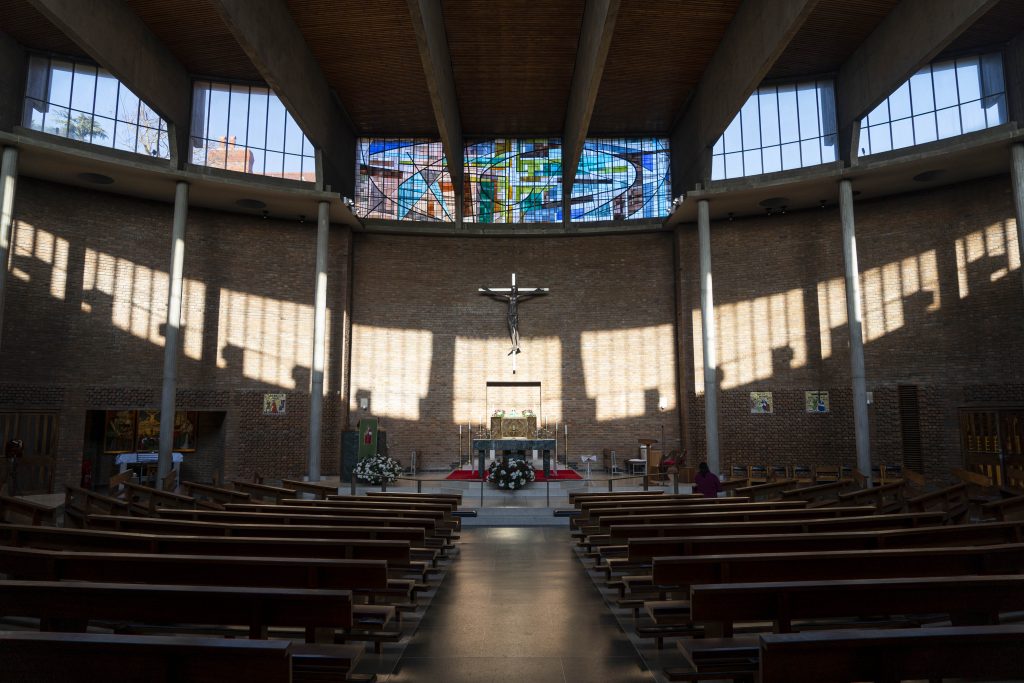Churches of the Day
Pictorial Thought for Today
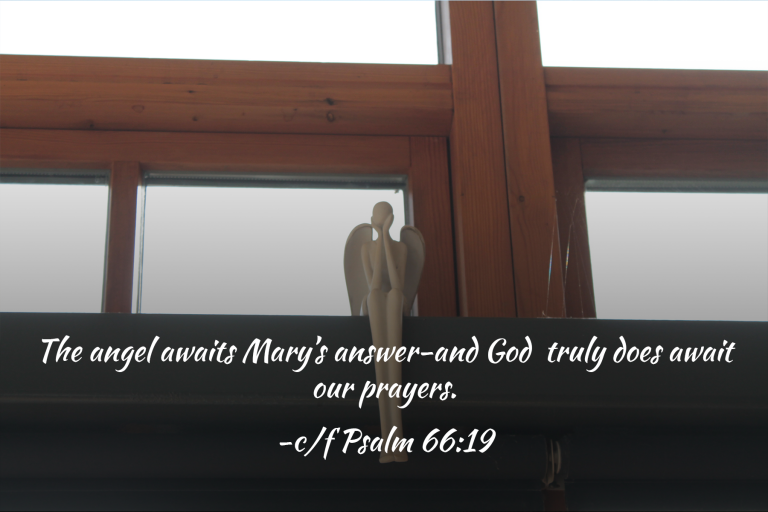
Nov 28 - St Catherine Labouré (1806-76) Daughter of Charity, visionary
Early life
Patrick Duffy tells her story.
Zoë Labouré was born at Fain-les-Moutiers near Dijon in the Cote d'Or, the eighth of ten children of farmer Peter Labouré and his wife Magdalene Gontard. For several years she looked after her widowed father, then as a waitress in her uncle's café in Paris.
Rue de Bac
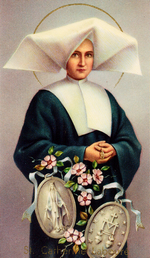 Zoë joined the Daughters of Charity at the Rue de Bac convent in Paris, taking the name Catherine. Here she did her novitiate and was professed. During her novitiate she had visions in the convent chapel, but hardly anyone knew about these until a few months before her death.
Zoë joined the Daughters of Charity at the Rue de Bac convent in Paris, taking the name Catherine. Here she did her novitiate and was professed. During her novitiate she had visions in the convent chapel, but hardly anyone knew about these until a few months before her death.Subsequently she lived at Reuilly (Paris) for 46 years. She acted as portress, looked after the elderly in a rest-home and tended the poultry.
Miraculous Medal
Catherine was described as matter of fact and unemotional by temperament. But some months before her death, she reported that during her novitiate the Virgin Mary appeared to her standing on a globe with shafts of light coming from her hands;
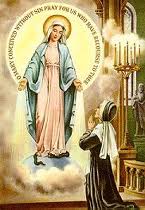 she was surrounded by the inscription
she was surrounded by the inscription"Mary conceived without sin, pray for us who have recourse to thee" and an inward voice told her to have a medal struck embodying Mary of the Immaculate Conception on one side and on the other a capital M with the cross over the hearts of Jesus and Mary surrounded by twelve stars (Apoc 12:1). She said she was told to have this produced as a medal: 1500 were minted in 1832, authorised by the archbishop of Paris. In 1836 a canonical enquiry accepted the visions as authentic.
A jew converts and Becomes Priest
This judgment seemed to be confirmed when an Alsatian Jew, Alphonse Ratisbonne, was converted to Christianity in 1842, became a priest, and founded the Fathers and Sisters of Sion. After this the Miraculous Medal devotion was widely propagated.
Death and Canonisation
Catherine died in 1876. Her incorrupt body remains
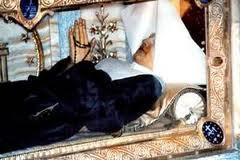 in the convent chapel in the Rue de Bac, Paris. Miracles were reported at her tomb. She was beatified in 1933 and canonised in 1947.
in the convent chapel in the Rue de Bac, Paris. Miracles were reported at her tomb. She was beatified in 1933 and canonised in 1947.The image (right) shows her incorrupt body at the Rue de Bac convent in Paris.
__________________
******************************
Memorable Saying for Today
'A happy life must be to a great extent a quiet life,
for it is only in an atmosphere of quiet that true joy can live.'
~Bertrand Russell ~
******************************
Friday of the Thirty Fourth Week in Ordinary Time, Cycle 1
The four kingdoms of Babylon were represented by four beasts. After them the Messianic King will come.
FIRST READING
A reading from the prophet Daniel 7:2-14
And I saw, coming on the clouds of heaven, one like a son of man.
I , Daniel said, have been seeing visions in the night.
I saw that the four winds of heaven were stirring up the great sea; four great beasts emerged from the sea, each different from the other.
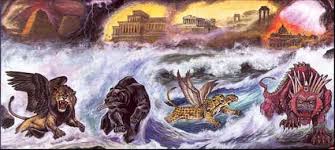
The first was like a lion with eagle's wings; and as I looked its wings were torn off, and it was lifted from the ground and set standing on its feet like a man; and it was given a human heart.
The second beast I saw was different, like a bear, raised up on one of its sides, with three ribs in its mouth, between its teeth. "Up!" came the command "Eat quantities of flesh!"
After this I looked, and saw another beast, like a leopard, and with four bird's wings on its flanks; it had four heads, and power was given to it.
Next I saw another vision in the visions of the night: I saw a fourth beast, fearful, terrifying, very strong; it had great iron teeth, and it ate, crushed and trampled underfoot what remained. It was different from the previous beasts and had ten horns.
'While I was looking at these horns, I saw another horn sprouting among them, a little one; three of the original horns were pulled out by the roots to make way for it; and in this horn I saw eyes like human eyes, and a mouth that was full of boasts. As I watched:

'Thrones were set in place and one of great age took his seat.
His robe was white as snow, the hair of his head as pure as wool.
His throne was a blaze of flames, its wheels were a burning fire.
A stream of fire poured out, issuing from his presence.
A thousand thousand waited on him, ten thousand times ten thousand stood before him. A court was held and the books were opened.
'The great things the horn was saying were still ringing in my ears, and as I watched, the beast was killed, and its body destroyed and committed to the flames. The other beasts were deprived of their power, but received a lease of life for a season and a time.

I gazed into the visions of the night.
And I saw, coming on the clouds of heaven, one like a son of man.
He came to the one of great age and was led into his presence.
On him was conferred sovereignty, glory and kingship,
and men of all peoples, nations and languages became his servants.
His sovereignty is an eternal sovereignty which shall never pass away,
nor will his empire ever be destroyed.
The Word of the Lord. Thanks be to God.
Responsorial Psalm Dan 3: 75-81 Rv: 59
Response Give glory and eternal praise to him!
1. Mountains and hills! bless the Lord. R/v Give glory and eternal praise to him!
2. Everything that grows on the earth!
bless the Lord. R/v Give glory and eternal praise to him!
3.Springs of water! Bless the Lord R/v Give glory and eternal praise to him!
4. Seas and rivers, Bless the Lord R/v Give glory and eternal praise to him!
5. Sea beasts and everything that lives
in the water! Bless the Lord R/v Give glory and eternal praise to him!
6. Birds of heaven! Bless the Lord R/v Give glory and eternal praise to him!
7. Animals wild and tame! Bless the Lord R/v Give glory and eternal praise to him!
Gospel Acclamation Lk 21: 28
Alleluia, alleluia!
Stand erect, hold your heads high, because your liberation is near at hand.
Alleluia!
GOSPEL
The Lord be with you. And with your spirit
A reading from the holy Gospel according to Luke 21:29-33 Glory to you, O Lord.
When you see these things happening: know that the kingdom of God is near.
 Jesus told them a parable,
Jesus told them a parable,'Think of the fig tree and indeed every tree. As soon as you see them bud, you know that summer is now near. So with you when you see these things happening: know that the kingdom of God is near.
I tell you solemnly, before this generation has passed away all will have taken place.
Heaven and earth will pass away, but my words will never pass away.'
The Gospel of the Lord. Praise to you, Lord Jesus Christ.
**************************
Gospel Reflection Friday Thirty Fourth Week in Ordinary Time Luke 21:29-33
We are all familiar with the hymn, ‘Abide With Me’. In one of the verses we sing,
‘change and decay in all around I see, O thou who changest not, abide with me’.
There is a recognition that everything changes, everything passes, but the Lord himself does not change or pass away. That sentiment is very much in keeping with what Jesus says in today’s gospel reading. Jesus has been speaking about so much that is destined to pass away, including the wonderful Temple in Jerusalem, the city of Jerusalem itself, even the elements of the cosmos. Yet, he declares that ‘my words will never pass away’. The Lord’s words will never pass away because he himself will never pass away.
In the Book of Revelation, the risen Lord declares, ‘I am the Alpha and the Omega, the first and the last, the beginning and the end’. He is our past, our present and our future. His loving presence in our lives endures forever. In his first letter to the Corinthians, Paul says, ‘Love never ends’. God who is love never ends, and Jesus who is God in human form never ends. His loving presence is steadfast, enduring and faithful. All genuine love is life-giving and the Lord’s enduring love is supremely live-giving for us, bringing new life out of death itself. The Lord’s love endures beyond this earthly life and his relationship with us endures beyond this earthly life. It changes but does not end. Because the Lord’s love endures, never passes away, we can look forward in hope to a deepening of our relationship with him beyond this earthly life.
________________________________
The Scripture Readings are taken from The Jerusalem Bible, published 1966 by Darton, Longman & Todd Ltd. and used with the permission of the publishers. http://dltbooks.com/
The Scripture Reflection is made available with our thanks from his book Reflections on the Weekday Readings : Your word is a lamp for my feet and light for my path by Martin Hogan and published by Messenger Publications c/f www.messenger.ie/bookshop
_____________________
Sliocht as an fáidh Dainéil 7:2-14
Féach! neach ag teacht ar néalta neimhe, amhail Mac an Duine.
Dainéil: Chonaic mé físeanna istoíche.
'Féach! Bhí ceithre ghaoth neimhe ag coipeadh na bóchna móire.
Tháinig ceithre ainmhí mór aníos as an fharraige, gach ceann acu éagsúil lena chéile.
Bhí an chéad cheann mar leon agus sciatháin iolair air. Ansin, agus mé ag féachaint air, stolladh a sciatháin de, ardaíodh ó thalamh é agus chaith sé seasamh ar dhá chois amhail duine, agus tugadh croí duine dó. Féach!

Ainmhí eile, an dara ceann, agus é cosúil le béar, ardaithe ar a leathchliathán, agus trí easna ina bhéal idir a fhiacla. Dúradh leis: ‘Éirigh, alp siar a lán feola.’
Ina dhiaidh sin d’fhéach mé, agus b’sheo ceann eile mar liopard, agus ceithre sciathán éin ar a dhroim; bhí ceithre cheann ar an ainmhí agus tugadh tiarnas dó.
Ina dhiaidh seo rinneadh físeanna oíche dom, agus féach, an ceathrú hainmhí, uafar, scéiniúil, agus róthréan; bhí aige fiacla móra iarainn, agus shlog agus stoll sé, agus phasáil sé an fuílleach faoina chosa. Bhí sé éagsúil leis na hainmhithe eile go léir a bhí roimhe. Bhí deich n-adharc air.
Bhreithnigh mé na hadharca, agus féach, d’éirigh ina measc ceann eile, adhaircín, agus stoitheadh trí cinn de na chéad adharca aníos lena theacht. Agus b’sheo súile mar shúile duine san adharc seo, agus béal ag caint is ag rá nithe móra. Bhí mé ag faire:
 Cuireadh cathaoireacha ríoga ina n-ionad agus shuigh Sinsear na Laethanta.
Cuireadh cathaoireacha ríoga ina n-ionad agus shuigh Sinsear na Laethanta.Bhí a éide ar lí an tsneachta, agus folt a chinn mar olann ghlan.
Ba lasair thintrí a chathaoir ríoga, agus ba thine spréacharnach a rothaí.
Ling sruth tine agus bhrúcht amach roimhe.
Bhí míle míle ag fónamh dó agus deich míle de dheich mílte ina seasamh os a chomhair.
Shuigh an chúirt i mbreithiúnas, agus osclaíodh na leabhair.
 “Toisc glór na nithe móra a bhí á rá ag an adharc a bheith á chloisteáil agam, d’fhéach mé, agus, ag faire dom, maraíodh an t-ainmhí, milleadh a chorp agus caitheadh i leataobh é le dó sa tine. Maidir leis na hainmhithe eile, tógadh a dtiarnas chun siúil uathu, ach níor cuireadh deireadh lena saol go ceann ré agus aimsire.
“Toisc glór na nithe móra a bhí á rá ag an adharc a bheith á chloisteáil agam, d’fhéach mé, agus, ag faire dom, maraíodh an t-ainmhí, milleadh a chorp agus caitheadh i leataobh é le dó sa tine. Maidir leis na hainmhithe eile, tógadh a dtiarnas chun siúil uathu, ach níor cuireadh deireadh lena saol go ceann ré agus aimsire.Chonaic mé i bhfíseanna oíche.
Féach! neach ag teacht ar néalta neimhe, amhail Mac an Duine.
Tháinig sé chun Sinsir na Laethanta, agus cuireadh os a chomhair é.
Dó siúd tugadh tiarnas, glóir is ardfhlaitheas,go bhfónfadh dó an uile phobal, chine agus theanga.
Tiarnas síoraí a thiarnas,nach rachaidh ar ceal, ná ní scriosfar a ríocht.
Briathar an Tiarna Buíochas le Dia
Salm le Freagra Dain 3: 75-81 Rv: 59
Freagra Molaigí é agus móraigí é go hard de shíor.
1. Glóirígí an Tiarna, a shléibhte agus a chnoca, Freagra
2. Glóirígí an Tiarna, a luibheanna a fhásann ar an talamh, Freagra
3. Glóirígí an Tiarna a thoibreacha uile, Freagra
4. Glóirígí an Tiarna, a fharraigí agus a aibhneacha, Freagra
5. Glóirígí an Tiarna, a mhíola móra agus
gach a ngluaiseann sna huiscí, Freagra
6. Glóirígí an Tiarna, a éanlaith uile an aeir, Freagra
7. Glóirígí an Tiarna, a ainmhithe agus a tháinte, Freagra
SOISCÉAL
Go raibh an Tiarna libh. Agus le do spiorad féin
Sliocht as an Soiscéal naofa de réir Lúcás 21:29-33 Glóir duit, a Thiarna.
Nuair a fheicfidh sibh na nithe úd ag teacht, bíodh a fhios agaibh go bhfuil ríocht Dé in achmaireacht.
San am sin labhair Íosa parabal leo:
“Féachaigí an crann fígí agus na crainn eile. Nuair a bhíonn siad ag

eascar, bíonn a fhios agaibh ag féachaint orthu, go bhfuil an samhradh in achmaireacht feasta. Amhlaidh sin daoibh nuair a fheicfidh sibh na nithe úd ag teacht, bíodh a fhios agaibh go bhfuil ríocht Dé in achmaireacht. Deirim libh go fírinneach, ní imeoidh an ghlúin seo gan gach uile ní a bheith tagtha chun cinn.
Imeoidh neamh agus talamh, ach ní imeoidh mo bhriathrasa choíche."
Soiscéal an Tiarna. Moladh duit, a Chriost
AN BÍOBLA NAOFA
© An Sagart

November. 30th 2025, |First Sunday of Advent,
Todays liturgy is the first one of the new Church Year A: 2025/2026,
The Second Coming of Christ/Day of Judgement will be the day when our lives will be
truly, fairly and lovingly evaluated by God.
FIRST READING
A reading from the book of the Prophet Isaiah 2:1-5
Come, let us go up to the mountain of the Lord that he may teach us his ways so that we may walk in his paths.
The vision of Isaiah son of Amoz, concerning Judah and Jerusalem.
 'In the days to come the mountain of the Temple of the Lord shall tower above the mountains and be lifted higher than the hills. All the nations will stream to it, peoples without number will come to it; and they will say: 'Come, let us go up to the mountain of the Lord, to the Temple of the God of Jacob that he may teach us his ways so that we may walk in his paths; since the Law will go out from Zion, and the oracle of the Lord from Jerusalem'.
'In the days to come the mountain of the Temple of the Lord shall tower above the mountains and be lifted higher than the hills. All the nations will stream to it, peoples without number will come to it; and they will say: 'Come, let us go up to the mountain of the Lord, to the Temple of the God of Jacob that he may teach us his ways so that we may walk in his paths; since the Law will go out from Zion, and the oracle of the Lord from Jerusalem'.He will wield authority over the nations and adjudicate between many peoples; these will hammer their swords into ploughshares, their spears into sickles. Nation will not lift sword against nation, there will be no more training for war.'
O House of Jacob, come, let us walk in the light of the Lord.
The Word of the Lord Thanks be to God.
Responsorial Psalm Ps 121: 1-2,4-5,6-9, Rv v.1
Response I rejoiced when I heard them say: "Let us go to God's house."
1. I rejoiced when I heard them say: "Let us go to God's house."
And now our feet are standing within your gates, O Jerusalem. Response

2. It is there that the tribes go up, the tribes of the Lord.
For Israel's law it is, there to praise the Lord's name.
There were set the thrones of judgement of the house of David. Response
3. For the peace of Jerusalem pray: "Peace be to your homes!
May peace reign in your walls, in your palaces, peace !" Response
4. For love of my brethren and friends I say: "Peace upon you!"
For love of the house of the Lord I will ask for your good. Response
SECOND READING
A reading from the first letter of St Paul to the Romans 13:11-14
Our salvation is even nearer.
 You know 'the time' has come: you must wake up now:
You know 'the time' has come: you must wake up now:our salvation is even nearer than it was when we were converted.
The night is almost over, it will be daylight soon -
let us give up all the things we prefer to do under cover of the dark;
let us arm ourselves and appear in the light.
Let us live decently as people do in the daytime:
no drunken orgies, no promiscuity or licentiousness, and no wrangling or jealousy.
Let your armour be the Lord Jesus Christ.
The Word of the Lord Thanks be to God.
Gospel Acclamation Ps 84:8
Alleluia, alleluia!
Let us see, O Lord, your mercy and give us your saving help.
Alleluia!
GOSPEL
The Lord be with you. And with your spirit
A reading from the Gospel according to Matthew 24:37-44 Glory to you, O Lord
Stay awake, because you do not know the day when your master is coming.
Jesus said to his disciples:
'As it was in Noah's day, so will it be when the Son of Man comes.
 For in those days before the Flood people were eating, drinking, taking wives, taking husbands, right up to the day Noah went into the ark, and they suspected nothing till the Flood came and swept all away.
For in those days before the Flood people were eating, drinking, taking wives, taking husbands, right up to the day Noah went into the ark, and they suspected nothing till the Flood came and swept all away.It will be like this when the Son of Man comes. Then of two men in the fields one is taken, one left; of two women at the millstone grinding, one is taken, one left.
'So stay awake, because you do not know the day when your master is coming.
You may be quite sure of this that if the householder had known at what time of the night the burglar would come,
he would have stayed awake and would not have allowed anyone to break through the wall of his house.
Therefore, you too must stand ready because the Son of Man is coming at an hour you do not expect.'
The Gospel of the Lord Praise to you, Lord Jesus Christ.
**********************************************************
For homily resources for this Sunday's Gospel click here: https://www.catholicireland.net/sunday-homily/
________________
The scripture readings are taken from The Jerusalem Bible, 1966 published by Darton, Longman and Todd Ltd and used with the permission of the publishers.
_________________________
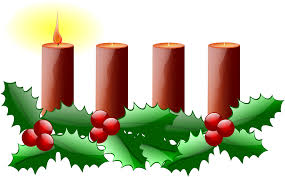
An Chéad Domhnach den Aidbhint Bliain A
AN CÉAD LÉACHT
Sliocht as an Leabhar Íseáia, Fáidh 2:1-5
Seo linn, téimis suas go sliabh an Tiarna chun go múine sé dúinn a shlite agus go siúlaimis a bhealaí.
Fís Íseáia mhic Ámóz i dtaobh Iúdá agus Iarúsailéim.
 Titfidh sé amach san am atá le teacht
Titfidh sé amach san am atá le teachtgo mbeidh an sliabh a bhfuil teach an Tiarna air os cionn na sléibhte, agus go dtógfar níos airde ná na cnoic é.
Tiocfaidh na ciníocha go léir ina sruth go dtí é; is iomaí pobal a rachaidh ann agus a déarfaidh:
“Seo linn, téimis suas go sliabh an Tiarna go teach Dhia Iacóib,
chun go múine sé dúinn a shlite agus go siúlaimis a bhealaí.”
Óir ó Shíón rachaidh an dlí amach, agus ó Iarúsailéim briathar an Tiarna.
Beidh smacht aige ar na ciníocha agus déanfaidh sé réiteach idir an iomad pobal, agus buailfidh siad a gclaímhte amach ina soic chéachta agus a sleánna ina gcorráin.
Ní thógfaidh na ciníocha an claíomh in aghaidh a chéile a thuilleadh ná ní chleachtfaidh siad cogadh níos mó.
A theaghlach Iacóib, tagaigí, agus siúlaimis i solas an Tiarna!
Briathar an Tiarna Buíochas le Dia
Salm le Freagra Sm 121: 1-2,4-5,6-9, Rv v.1
Freagra Rinne mé gairdeas nuair a dúradh liom.
'Téimis i dteach an Tiarna.'
1. Rinne mé gairdeas nuair a dúradh liom: 'Téimis i dteach an Tiarna.'

Tá ár gcosa ina seasamh cheana féin i do dhoirse, a Iarúsailéim. Freagra
2. Rinneadh cathair Iarúsailéim a go dlúth is go daingean.
Is chuici a ghabhann na treibheanna suas, treibheanna an Tiarna. Freagra
3. Ar son mo bhráithre agus lucht mo pháirte:
'Go raibh síocháin ionat!' Ar son theach an Tiarna, ár nDia, iarraim do leas. Freagra
AN DARA LEÁCT
Sliocht as céad Litir Naomh Pól chuig na Rómhánaigh 13:11-14
Is gaire dúinn ár slánú anois ná nuair a ghlacamar.

A bhráithre, nuair a thuigeann sibh an uair atá ann, is mithid daoibh dúiseacht as bhur gcodladh, mar is gaire dúinn ár slánú anois ná nuair a ghlacamar leis an gcreideamh. Tá sé i bhfad amach san oíche agus ní fada uainn an lá. Caithimis oibreacha an dorchadais uainn, mar sin, agus cuirimis orainn cathéide an tsolais. Mairimis go béasach mar dhaoine atá faoi sholas an lae, gan ragairne gan meisce, gan striapachas gan drúise, gan achrann gan éad. Agus cuirigí oraibh an Tiarna Íosa Críost mar éide agus ná bígí ag déanamh cúraim den cholainn d’fhonn a hainmhianta a shásamh.
Briathar an Tiarna Buíochas le Dia
Alleluia Versa
Alleluia, alleluia!
Taispeáin dúinn, a Thiarna, do thrócaire, agus tabhair dúinn cúnamh do shlánaithe.
Alleluia!
SOISCÉAL
Go raibh an Tiarna libh. Agus le do spiorad féin
Sliocht as Soiscéal naofa de réir Naomh Mhatha 24:37-44 Glóir duit, a Thiarna.
Bígí ag faire, dá bhrí sin, mar níl a fhios agaibh cén lá a thiocfaidh bhur dTiarna.
 San am sin dúirt Íosa lena dheisceabail:
San am sin dúirt Íosa lena dheisceabail:'Amhail mar a bhí laethanta Naoi, is amhlaidh sin a bheidh téarnamh Mhac an Duine. Óir, faoi mar a bhí siad sna laethanta úd roimh an díle, ag ithe agus ag ól, ag pósadh agus ag tabhairt le pósadh, go dtí an lá a ndeachaigh Naoi san áirc, agus gan a fhios acu aon ní gur tháinig an díle agus gur sciob léi iad uile; is mar sin freisin a bheidh téarnamh Mhac an Duine. Beidh beirt fhear sa ghort an uair sin: tógfar duine agus fágfar duine; beirt bhan ag meilt bhró: tógfar bean agus fágfar bean.
Bígí ag faire, dá bhrí sin, mar níl a fhios agaibh cén lá a thiocfaidh bhur dTiarna. “Bíodh a fhios agaibh é seo, áfach: dá mb’eol don fhear tí cén t-am san oíche a dtiocfadh an bithiúnach, bheadh sé ag faire agus ní ligfeadh sé ballaí a thí a réabadh.
Sibhse freisin, mar sin, bígí ullamh, óir is ar an uair nach síleann sibh a thiocfaidh Mac an Duine.'
Soiscéal an Tiarna. Moladh duit, a Chriost
________________________________________________
AN BÍOBLA NAOFA
© An Sagart




